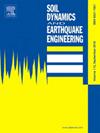Flowability for viscous fluid flow triggering liquefaction in saturated coral sand subjected to principal stress rotation
IF 4.2
2区 工程技术
Q1 ENGINEERING, GEOLOGICAL
引用次数: 0
Abstract
The reasonable determination of cyclic resistance in saturated sand is crucial for ensuring the long-term stability of marine structures. This paper investigates the liquefaction-induced flow characteristics of saturated coral sand specimens under complex cyclic loading conditions through cyclic shear tests with varying stress paths and frequencies. Experimental results demonstrate significant differences in deviatoric strain amplitude at the initial attainment of zero effective stress under different cyclic stress paths. To characterize cyclic resistance under complex loading, we introduce the unit cyclic stress ratio as a novel index. Notably, there are substantial differences in cyclic resistance between excess pore-water pressure (ue)-based and strain-based failure criteria across various cyclic loading modes. The specimens subjected to cyclic loading exhibit viscous fluid-like properties, leading us to propose a viscous fluid flow cyclic failure criterion within a comprehensive framework that considers both ue and strain. For practical engineering applications, it is noteworthy that cyclic resistance obtained from the viscous fluid damage criterion demonstrates greater conservatism, thereby providing enhanced safety assurance.
求助全文
约1分钟内获得全文
求助全文
来源期刊

Soil Dynamics and Earthquake Engineering
工程技术-地球科学综合
CiteScore
7.50
自引率
15.00%
发文量
446
审稿时长
8 months
期刊介绍:
The journal aims to encourage and enhance the role of mechanics and other disciplines as they relate to earthquake engineering by providing opportunities for the publication of the work of applied mathematicians, engineers and other applied scientists involved in solving problems closely related to the field of earthquake engineering and geotechnical earthquake engineering.
Emphasis is placed on new concepts and techniques, but case histories will also be published if they enhance the presentation and understanding of new technical concepts.
 求助内容:
求助内容: 应助结果提醒方式:
应助结果提醒方式:


